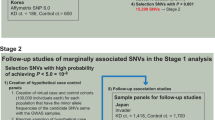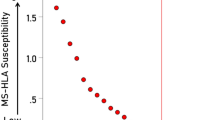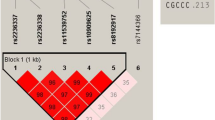Abstract
Herpes zoster is a common disease caused by reactivation of the varicella zoster virus (VZV). In a small number of herpes zoster patients, pain persists beyond 4 weeks or more after healing of vesicular eruptions; this condition is termed postherpetic neuralgia (PHN). Positive associations of human histocompatibility leukocyte antigens (HLA) class I antigens, A33 and B44, with PHN in the Japanese population have been reported. Our hypothesis is that susceptibility genes to PHN might exist in the HLA region and the study objective is to further examine possible associations of genes in HLA class I, II and III regions, HLA-A, -B, -DRB1, tumor necrosis factor α (TNFA) promoter, and a natural killer cell activating receptor, NKp30 polymorphisms with PHN. Although TNFA or NKp30 in the class III region had been considered as a candidate locus, we found no associations of TNFA promoter or NKp30 polymorphisms with PHN in this study. We demonstrated that HLA-A*3303, -B*4403 and -DRB1*1302 alleles were significantly associated with PHN (P=0.0007 for A*3303, P=0.001 for B*4403 and P=0.001 for DRB1*1302). The frequency of the HLA-A*3303-B*4403-DRB1*1302 haplotype was also significantly higher in the PHN patients than in the healthy controls (P=0.0039). Our results suggest that this haplotype might be related to the pathogenesis of PHN.
This is a preview of subscription content, access via your institution
Access options
Subscribe to this journal
Receive 6 digital issues and online access to articles
$119.00 per year
only $19.83 per issue
Buy this article
- Purchase on Springer Link
- Instant access to full article PDF
Prices may be subject to local taxes which are calculated during checkout
Similar content being viewed by others
References
Cluff RS, Rowbotham MC . Pain caused by herpes zoster infection Neurol Clin 1998 16: 813–832
Portenoy RK, Duma C, Foley KM . Acute herpetic and postherpetic neuralgia: clinical review and current management Ann Neurol 1986 20: 651–664
Abendroth A, Arvin A . Varicella-zoster virus immune evasion Immunol Rev 1999 168: 143–156
Gilden DH, Rozenman Y, Murray R, Devlin M, Vafai A . Detection of varicella-zoster virus nucleic acid in neurons of normal human thoracic ganglia Ann Neurol 1987 22: 377–380
Mainka C, Fuss B, Geiger H, Hofelmayr H, Wolff MH . Characterization of viremia at different stages of varicella-zoster virus infection J Med Virol 1998 56: 91–98
Miller AE . Selective decline in cellular immune response to varicella-zoster in the elderly Neurology 1980 30: 582–587
Vafai A, Wellish M, Gilden DH . Expression of varicella-zoster virus in blood mononuclear cells of patients with postherpetic neuralgia Proc Natl Acad Sci USA 1988 85: 2767–2770
Schmader K . Postherpetic neuralgia in immunocompetent elderly people Vaccine 1998 16: 1768–1770
Dworkin RH, Boon RJ, Griffin DR, Phung D . Postherpetic neuralgia: impact of famciclovir, age, rash severity, and acute pain in herpes zoster patients J Infect Dis 1998 178: (Suppl 1) S76–S80
Ozawa A, Sasao Y, Iwashita K et al. HLA-A33 and -B44 and susceptibility to postherpetic neuralgia (PHN) Tissue Antigens 1999 53: 263–268
Tokunaga K, Ishikawa Y, Ogawa A et al. Sequence-based association analysis of HLA class I and II alleles in Japanese supports conservation of common haplotypes Immunogenetics 1997 46: 199–205
Knight JC, Udalova I, Hill AV et al. A polymorphism that affects OCT-1 binding to the TNF promoter region is associated with severe malaria Nat Genet 1999 22: 145–150
Tsuchiya N, Kawasaki A, Tsao BP et al. Analysis of the association of HLA-DRB1, TNFalpha promoter and TNFR2 (TNFRSF1B) polymorphisms with SLE using transmission disequilibrium test Genes Immun 2001 2: 317–322
Matsushita M, Tsuchiya N, Nakayama T et al. Allele typing of human TNFA 5'-flanking region using polymerase chain reaction-preferential homoduplex formation assay (PCR-PHFA): linkage disequilibrium with HLA class I and class II genes in Japanese Tissue Antigens 1999 54: 478–484
Kawasaki A, Tsuchiya N, Hagiwara K, Takazoe M, Tokunaga K . Independent contribution of HLA-DRB1 and TNF alpha promoter polymorphisms to the susceptibility to Crohn's disease Genes Immun 2000 1: 351–357
Shibue T, Tsuchiya N, Komata T et al. Tumor necrosis factor alpha 5'-flanking region, tumor necrosis factor receptor II, and HLA-DRB1 polymorphisms in Japanese patients with rheumatoid arthritis Arthritis Rheum 2000 43: 753–757
Hohjoh H, Tokunaga K . Allele-specific binding of the ubiquitous transcription factor OCT-1 to the functional single nucleotide polymorphism (SNP) sites in the tumor necrosis factor-alpha gene (TNFA) promoter Genes Immun 2001 2: 105–109
Higuchi T, Seki N, Kamizono S et al. Polymorphism of the 5'-flanking region of the human tumor necrosis factor (TNF)-alpha gene in Japanese Tissue Antigens 1998 51: 605–612
Ihara T, Kamiya H, Starr SE, Arbeter AM, Lange B . Natural killing of varicella-zoster virus (VZV)-infected fibroblasts in normal children, children with VZV infections, and children with Hodgkin's disease Acta Paediatr Jpn 1989 31: 523–528
Terada K, Kawano S, Yoshihiro K, Morita T . Natural killer cell activity in herpes zoster in children without underlying disease Scand J Infect Dis 1993 25: 521–524
Lee SH, Girard S, Macina D et al. Susceptibility to mouse cytomegalovirus is associated with deletion of an activating natural killer cell receptor of the C-type lectin superfamily Nat Genet 2001 28: 42–45
Brown G, Dokun AO, Heusel JW et al. Vital involvement of a natural killer cell activation receptor in resistance to viral infection Science 2001 292: 934–937
Ferlazzo G, Tsang ML, Moretta L et al. Human dendritic cells activate resting natural killer (NK) cells and are recognized via the NKp30 receptor by activated NK cells J Exp Med 2002 195: 343–351
Sato M, Ohashi J, Tsuchiya N et al. Identification of novel single nucleotide substitutions in the NKp30 gene expressed in human natural killer cells Tissue Antigens 2001 58: 255–258
Thomee R, Grimby G, Wright BD, Linacre JM . Rasch analysis of Visual Analog Scale measurements before and after treatment of patellofemoral pain syndrome in women Scand J Rehab Med 1995 27: 145–151
Haldane JBS . The estimation and significance of the logarithm of a ratio of frequencies Ann Hum Genet 1955 20: 309–311
Tanaka H, Akaza T, Juji T . Report of the Japanese Central Bone Marrow Data Center In: Cecka JM, Terasaki PI, (eds) CLINICAL TRANSPLANTS. UCLA Tissue Typing Laboratory 1996 pp. 139–144
Imanishi T, Akaza T, Kimura A, Tokunaga K, Gojobori T . Estimation of allele and haplotype frequencies for HLA and complement loci. In: Tsuji K, Aizawa M, Sasazuki T, (eds) HLA 1991 Proceedings of the 11th International Histocompatibility Workshop and Conference Vol. 1: Oxford Science Publications: Oxford 1992 pp. 76–79
Kato N, Kikuchi A, Kano K, Egawa K, Takiguchi M . Molecular analysis of a novel HLA-A33 subtype associated with HLA-B44 Tissue Antigens 1993 41: 211–213
Kawai S, Maekawajiri S, Tokunaga K et al. Routine low and high resolution typing of the HLA-DRB gene using the PCR-MPH (microtitre plate hybridization) method Eur J Immunogenet 1996 23: 471–486
Acknowledgements
The authors would like to thank Drs Takeo Juji and Kenji Tadokoro (Japanese Red Cross Blood Center) for encouragement, and Drs Hidenori Tanaka and Junichi Ueki (Japanese Red Cross Blood Center) for technical help and suggestions. This study was supported by Grants-in-Aid for Scientific Research (B) and for Scientific Research on Priority Areas (C) ‘Medical Genome Science’ from the Ministry of Education, Science, Sports and Culture of Japan.
Author information
Authors and Affiliations
Corresponding author
Rights and permissions
About this article
Cite this article
Sato, M., Ohashi, J., Tsuchiya, N. et al. Association of HLA-A*3303-B*4403-DRB1*1302 haplotype, but not of TNFA promoter and NKp30 polymorphism, with postherpetic neuralgia (PHN) in the Japanese population. Genes Immun 3, 477–481 (2002). https://doi.org/10.1038/sj.gene.6363890
Received:
Revised:
Accepted:
Published:
Issue Date:
DOI: https://doi.org/10.1038/sj.gene.6363890
Keywords
This article is cited by
-
The demographic, laboratory and genetic factors associated with long Covid-19 syndrome: a case–control study
Clinical and Experimental Medicine (2024)
-
The impact of HLA polymorphism on herpesvirus infection and disease
Immunogenetics (2023)
-
Increased herpes zoster risk associated with poor HLA-A immediate early 62 protein (IE62) affinity
Immunogenetics (2018)
-
Looking back to move forward: a twenty-year audit of herpes zoster in Asia-Pacific
BMC Infectious Diseases (2017)
-
Clinical features of and genetic predisposition to drug-induced Stevens–Johnson syndrome and toxic epidermal necrolysis in a single Korean tertiary institution patients—investigating the relation between the HLA -B*4403 allele and lamotrigine
European Journal of Clinical Pharmacology (2015)



